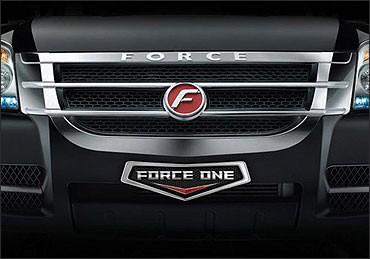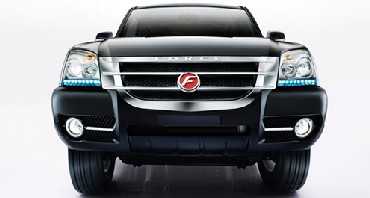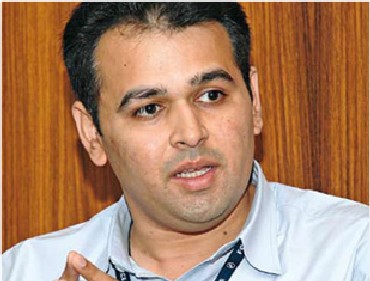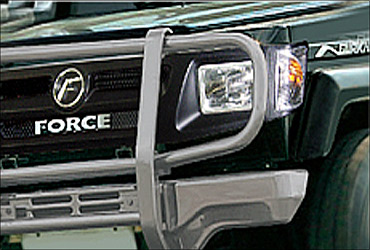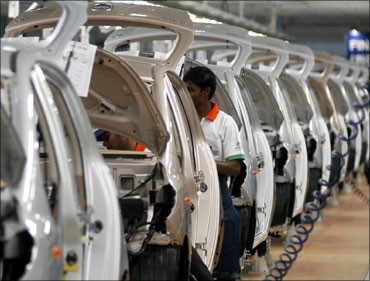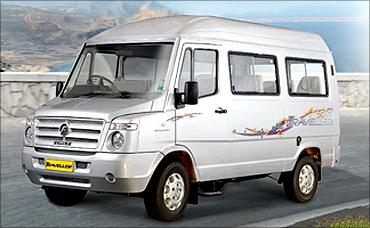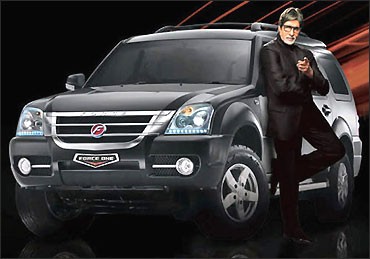 | « Back to article | Print this article |
Can Force Motors make a mark in SUVs?
Force India had launched the Force One, its sports utility vehicle, or SUV, in 2011, and got Bollywood superstar Amitabh Bachchan to endorse it.
Yet, it has managed to sell only 2,000 units so far this year.
SUVs are the fastest-growing segment of the Indian car market.
Many of the popular models have gone into short supply; yet, customers are ready to wait for months together for delivery.
Force Motors is a small player.
Mahindra & Mahindra, the market leader, has sold almost 170,000 SUVs (the Scorpio, Bolero and XUV 500) so far this year, while Tata Motors (the Sumo, Safari and Aria) has sold almost 32,000 and Toyota (Innova and Fortuner) has sold nearly 60,000. Newcomer Renault has managed to sell nearly 20,000 units of its SUV, the Duster.
Click NEXT to read further. . .
Can Force Motors make a mark in SUVs?
This huge gap doesn't bother Prasan Firodia, the young managing director of the Pune-headquartered Force Motors.
"When we started, we had a target of selling 4,000 units; we have reached only 50 per cent of that. Is it satisfactory?
"Definitely not, but given the fact that everything is new, it has been quiet exciting," he says.
The 'new' which Firodia refers to is Force Motors' foray into the personal vehicle category.
For over five decades, the company has been making commercial products like three-wheelers, mini trucks, large trucks, tractors, mini buses, utility vehicles, pick-ups and even ambulances.
Click NEXT to read further. . .
Can Force Motors make a mark in SUVs?
It is only with the Force One that the company has got into the consumer segment.
This segment is crowded with domestic heavyweights and multinationals and the buyer is discerning.
Force Motors has a strong network of over 180 dealers for its commercial vehicles, but these can't be used to sell SUVs.
So, it had to set up a whole new network of dealerships for the Force One.
So far, it has been able to appoint 25 of them. In one year, the company hopes to double the dealerships to 50.
To sustain them, Firodia needs to come out with more and more products.
Click NEXT to read further. . .
Can Force Motors make a mark in SUVs?
"With just one product, it will be very difficult to succeed.
Second, the distribution strategy needs to be there, it is important that you have the maximum reach," says Abdul Majeed, executive director, PricewaterhoueCoopers India.
Critics also say that Force Once has some distance to cover to match up with its peers in terms of fit and finish and driving comfort.
Bigger portfolio
The company is thus pumping in about Rs 1,000 crore (Rs 10 billion) into operations, new products, modernisation of equipment, a new paint shop and upgrading its engine and testing facilities.
A seven-seat Force One comes with a price tag of Rs 11.4 lakh in Maharashtra.
This is substantially higher than Toyota's eight-seat Innova whose Euro III model sells for Rs 880,000.
Click NEXT to read further. . .
Can Force Motors make a mark in SUVs?
To counter this, Force Motors will launch an affordable version of the Force One by February, in addition to a fully-loaded top line version.
The cheaper version will not have some creature comforts that are in the existing model. This will be followed by the launch of a new 4X4 SUV named Gurkha in the later part of the next year.
The Gurkha, a brand which is making a comeback after a three-year hiatus, will be positioned as the ultimate off-roader with brutish and muscular looks but basic interiors. In looks, the Gurkha could be confused with the Mercedes-Benz's premium SUV, the G Wagen.
That's because Force Motors has sourced the design and styling for the Gurkha from the German automobile maker.
Click NEXT to read further. . .
Can Force Motors make a mark in SUVs?
A true-blue off-roader, the G Wagen, which costs above Rs 1 crore (Rs 10 million) in India, could perhaps provide its strong chassis to the Gurkha too.
Force Motors' association with Daimler-Benz is not new and will not be limited just to the Gurkha.
Its mini bus, the Traveller, the highest revenue generator for the company, is based on the T1 Transporter developed by Mercedes-Benz.
The engine, gearbox and axle seen on the Force One is built under licence from Mercedes-Benz, the same technology will be shared with the all-new Gurkha.
The alliance will be further strengthened next year when Firodia launches its premium van, which again shares its technology with a Mercedes-Benz product.
Click NEXT to read further. . .
Can Force Motors make a mark in SUVs?
"The van is made under licence from Mercedes in totality, be it its driveline, body etc. The launch will be by the end of next year.
"Right now, we are building a new facility with new body and paint shop, and a new final assembly line at Pithampur in Madhya Pradesh.
We are putting in Rs 500 crore (Rs 5 billion) into the new van," Firodia says.
The van is based on the Mercedes-Benz Viano, also known as V-Class in some markets. The multi-seat premium vehicle is sold in Mexico, Spain and China by the German company.
In India, under the banner of Force Motors, the van will perhaps compete against the Nissan Evalia or the Tata Motors Aria.
Click NEXT to read further. . .
Can Force Motors make a mark in SUVs?
The multi-purpose, high-end van will be the second new platform for Force Motors after the Force One.
The company says that based on the success of the new products planned for the immediate future, it would explore the possibility of having more spin-off products using the same platform.
Strategic collaboration
By not investing in the development of a new platform, Force Motors is conserving cash -- something it could use to add marketing muscle in the fiercely competitive market.
According to industry estimates, developing a new vehicle, including the platform from scratch, entails an investment of anywhere between $500 million and $1 billion (Rs 2,700 crore to Rs 5,500 crore).
The image used is for representative purpose only
Click NEXT to read further. . .
Can Force Motors make a mark in SUVs?
"Why should I unnecessarily reinvent the wheel when I have the source?
"And I am buying technology from Mercedes.
I am not buying technology which is second standard or third standard. If you look at original equipment manufacturers today, everybody is talking about platform sharing," adds Firodia.
Though Force Motors competes against all the other manufacturers, its primary target areas, however, remain outside the four big cities where larger vehicles face much higher demand.
Click NEXT to read further. . .
Can Force Motors make a mark in SUVs?
The Force One, for instance, is as huge as the Ford Endeavour.
The company is not focusing on smaller vehicles for now.
"Our market is not going to be Tier-I cities like the metros (only).
"These are the markets where people will appreciate a smaller SUV. So, we are identifying the places where we can do well; it could be places like Aurangabad, Nagpur, Kochi and Surat," adds Firodia.
Last financial year, the company cracked the Rs 2,000-crore (Rs 20 billion) turnover milestone at Rs 2,003 crore (Rs 20.03 billion), a growth of 33 per cent over Rs 1,504 crore (Rs 15.04 billion) posted in the corresponding earlier year.
Click NEXT to read further. . .
Can Force Motors make a mark in SUVs?
Net profit during last year stood at Rs 824 crore (Rs 8.24 billion), against Rs 58 crore (Rs 580 million) posted in the corresponding earlier year.
A little over Rs 1,000 crore (Rs 10 billion) was gained by the company last year after it sold almost its entire stake in the MAN Force Trucks joint venture company to its partner MAN Trucks and Bus AG, Germany.
That company made heavy-duty trucks for mining and construction applications.
Newer products and more variants, the company hopes, will push sales volumes in the personal vehicle space to more than double from 2,000 units.
"With the new variants coming in and new dealerships being set up, I would expect us to at least double our sales compared to what we did in the first year.
"Anywhere between 5,000 and 7,000 units is what one can aspire for," says Firodia.
